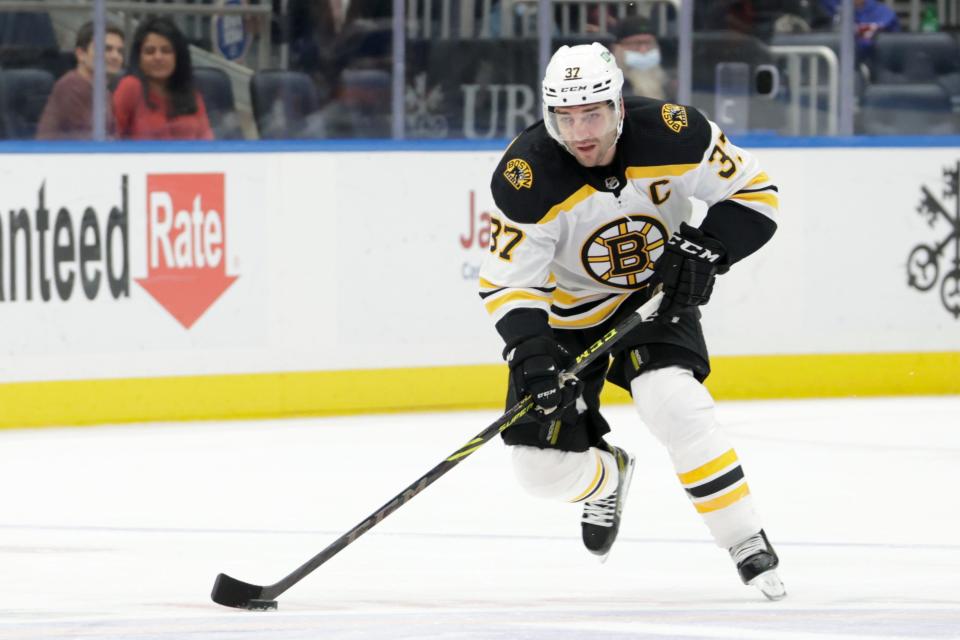Seven-game loss to Carolina exposed a lingering lack of toughness in Boston's attack
- Oops!Something went wrong.Please try again later.
- Oops!Something went wrong.Please try again later.
- Oops!Something went wrong.Please try again later.
- Oops!Something went wrong.Please try again later.
- Oops!Something went wrong.Please try again later.
- Oops!Something went wrong.Please try again later.
- Oops!Something went wrong.Please try again later.
A tweet got me thinking: So just who is the "monkey wrench team" of the 2022 Stanley Cup playoffs?
The tweet, from Stephen Smith (no middle initial that I know of) — no, this guy is the author of "Puckstruck: Distracted, Delighted and Distressed by Canada's Hockey Obsession" — showed the photo of the deadly looking monkey wrench that in 1926 was thrown by a Boston fan at Toronto St. Patricks Coach Charlie Querrie. Somehow, it was memorialized as a desk ornament with a clock in the office of Bruins Coach Art Ross.
The aforementioned question annually reboots when playoff hockey begins turning the regular season upside down.
The nickname for this pastime crystalized after the 1995 New Jersey Devils caused four coaching staffs panic-stricken hours holed up in offices watching video and reinventing their breakouts. Jacques Lemaire's laterally aggressive adaptation of Montreal's old 1-2-2 forecheck — it was not a neutral-zone trap — made a league full of copycats.
Half the fun of watching hockey right now is trying to identify the "monkey wrench team" of the playoffs.

In 2011, Claude Julien obliged my question and said, "I think we can be the monkey-wrench team of the playoffs." Alas, they were. And the Bruins' sleeper hold, the element that changed hockey jargon, was their heavy game.
"Strong on our skates, strong on our sticks," Julien would say.
He canceled the chaos of the game with layers of zone defense, puck support and ultimately puck possession.
It took a special group of players of varying attributes to make it work, and it most famously did for the Bruins and the Los Angeles Kings. When both teams aged out of Cup contention in 2015, reinvention was challenging.
In Boston, General Manager Don Sweeney and Coach Bruce Cassidy had established synergy in the minors and updated Julien's systems with a Swiss Army Knife approach, designed for any kind of game.
Their only close brush with glory arrived prematurely, and they were not ready to seize the day against a more rugged, savvier opponent (St. Louis) that strangely resembled their 2011 big brothers.
Since then, the Bruins have said goodbye to Zdeno Chara, Tuukka Rask and David Krejci. Now they fear a most-devastating loss.
If he plays next season, captain Patrice Bergeron's age would match his jersey number (37). He is without a contract for the first time since age 18, making it half a life spent as a Bruin. With a family to consider now, his decision will define management's offseason mission.
Even with Bergeron, what the Bruins had wasn't enough against Carolina. Not only were the Hurricanes faster and more physical, they played with more chemistry. They read off each other quicker. Their playmakers were a split second more dangerous.
The Canes pinned the Bruins on the ropes for minutes at a time, including the games in Boston. Every series they win, Boston looks better, but going seven with Carolina was deceptive. The Bruins were never close to victory down there.
Are the Canes, Tony DeAngelo and their postgame rituals included, the monkey-wrench team of these playoffs? Time will tell. The Blues would like a word, as the vaunted Avalanche suddenly can't find any pace or any space.
Contrary to things you might read, Cassidy, Sweeney and team president Cam Neely are on the same page: The Bruins need more grit in their attacking game.
Bravo. If they really mean it this time.
Nick Foligno, like David Backes before him, arrived with the right attitude and too many miles. Trent Frederic offered fits and starts. In a desperate attempt to reinvent a Corvette into a tractor, Cassidy parked Taylor Hall in front of the net.
The Bruins nibbled around the edges of a lingering deficiency.
Until Hampus Lindholm, they only nibbled around the edges of their matchup problem on left defense. Sweeney knocked the trade deadline out of the park. With or without Bergeron, his offseason needs to be that good to his forward lines.
Bergeron's retirement is inevitable, but Brad Marchand's mileage is also accumulating; he wasn't himself against Carolina and may be facing hip surgery.
On Wednesday, Sweeney identified Marchand as a player with classic power-forward attributes despite his size, but a lack of like-minded, able-bodied cohorts reflects on management's patience with Frederic.
Whatever the Bruins do vis-a-vis Bergeron's decision or Jake DeBrusk's lingering trade request, any offseason maneuvering must identify and seize opportunities to put harder, meaner shoulders on Boston's top two forward lines.
More than what a new GM or coach or even a Krejci comeback could offer, the nibbling has to stop here.
Mick Colageo writes about hockey for The Standard-Times. Follow on Twitter @MickColageo.
This article originally appeared on Standard-Times: Playoff ouster exposed a lingering lack of toughness in Bruins' attack

